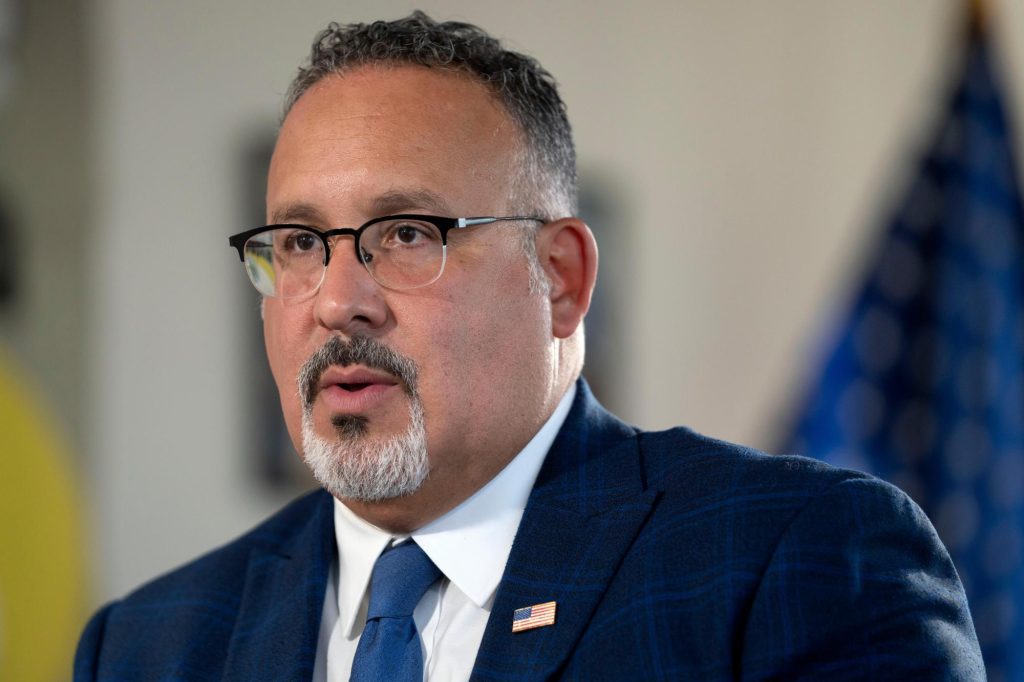By COLLIN BINKLEY (AP Education Writer)
WASHINGTON (AP) — The U.S. Education Department has found an error in the calculation of financial aid for hundreds of thousands of students. These applications were sent to colleges this month, but now they need to be redone. This mistake is part of a series of errors and may cause further delays in college applications for this year.
The federal government's vendor made a mistake in the financial aid formula for over 200,000 students, which was sent to colleges. Now, this information needs to be recalculated. At the same time, the department is dealing with a backlog of more than 4 million other financial aid applications.
The Education Department assures that 1.3 million applications that were already processed and sent to colleges this month are not affected by the problem. They claim to have fixed the error, and it will not impact future records.
It's unlikely that many students, if any, have received incorrect financial aid offers because the department only began sending records in the last two weeks. Usually, it takes colleges several weeks to put together financial aid packages once they receive this information.
This year, students applying to college have been left uncertain as they await the Education Department's changes to the Free Application for Federal Student Aid (FAFSA). FAFSA is used to determine eligibility for federal Pell Grants, as well as for colleges and states to award their own financial aid.
The update was supposed to simplify the form but ended up taking much longer than expected. This gives colleges less time to offer financial aid to students and gives students less time to decide where to enroll.
Justin Draeger, president and CEO of the National Association of Student Financial Aid Administrators, commented, “This mistake is another unforced error that will probably cause more delays for students.”
He added, “After so many delays, every error adds up and will be keenly felt by every student relying on need-based financial aid to pursue their postsecondary dreams.”
The latest mistake is related to the Student Aid Index, a new formula to determine students’ financial need after they submit the FAFSA application. The agency memo sent to colleges on Friday stated that the department failed to consider certain financial assets such as investments, savings, and total cash for some students.
As a result, it gave these students a lower Student Aid Index, indicating they have more financial need than they actually do.
While the department corrects these students’ records, it advises colleges to do their own calculations and create “a tentative aid package.”
Draeger disagreed with this idea, saying that colleges can only work with “valid and correct data.”
He said, “Sending out incorrect FAFSA data and asking thousands of schools to make real-time calculations and adjustments to the federal formula is not feasible or realistic.”
Supporters worry that the disorder of this year’s process could discourage students from going to college, especially those who consider finances a crucial part of the decision.
Republicans in the Senate are asking for a hearing with Education Secretary Miguel Cardona to talk about their “serious concerns” about the FAFSA rollout.
On Friday, Republican Sen. Bill Cassidy of Louisiana said in a video message that it’s not fair to ask colleges to correct the department’s error.
Cassidy, the leading Republican on the Senate Committee on Health, Education, Labor and Pensions, said, “You were supposed to get it done right the first time, and you were supposed to get it done right three months ago. We need more accountability, responsibility, and confidence from the Department of Education.”
The extremely time-consuming FAFSA form was targeted for a revamp in 2020 through a bipartisan legislation in Congress. The bill pledged to simplify the form, reducing the questions from 100 to fewer than 40, and it also changed the underlying formula for student aid, promising to expand it to more low-income students.
However, the update has been marred by delays and technical problems.
The form is usually available to complete in October, but the Education Department didn’t have it ready until late December. Even then, the agency wasn’t ready to start processing the forms and sending them to states and colleges, which only began this month.
Throughout the process, the department has been working to fix numerous bugs. Initially, the process failed to account for inflation correctly. Another issue prevented parents without a Social Security number from filling out the form. This meant many students who are U.S. citizens or permanent residents but have non-citizen parents couldn't apply.
The department claims that those issues have been resolved, and it’s now hurrying to process millions of student applications and send them to colleges and states. The agency says it has processed 1.5 million applications out of about 6 million received so far.
The department’s statement said, “We will continue delivering large volumes” of records in the next few weeks. “We remain focused on helping students and families through this process and supporting colleges produce aid offers as quickly as possible.”
___
The Associated Press’ education coverage receives financial support from multiple private foundations. AP is solely responsible for all content. Find AP’s standards for working with philanthropies, a list of supporters and funded coverage areas at AP.org.









